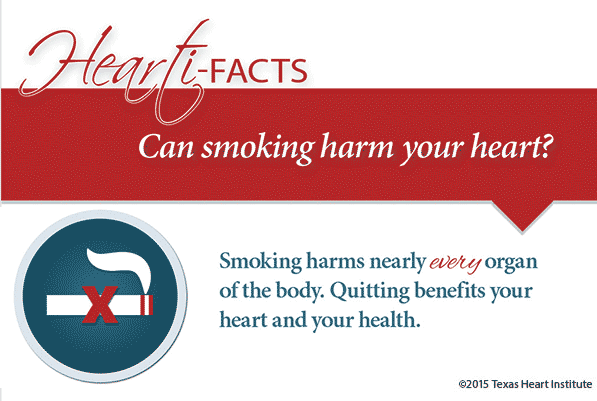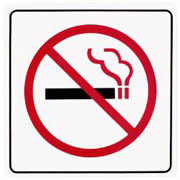
|

|
|
Learn the dangers of smoking (tobacco use) and the benefits of quitting.
Find resources to help you quit!
|
Most people know that cigarette and tobacco smoking increases the risk of lung cancer and breathing problems, but few realize that it also greatly increases the risk of heart disease, peripheral vascular disease (disease in the vessels that supply blood to the arms and legs) and abdominal aortic aneurysm.
According to the Centers for Disease Control and Prevention, the effects of cigarette smoking account for about 480,000 deaths each year in the United States—that is nearly 1 out of every 5 deaths. In fact, more deaths are caused each year by smoking than deaths from human immunodeficiency virus (HIV), illegal drug use, alcohol use, motor vehicle accidents, and firearm-related incidents combined. Also, about 80% of all deaths from chronic obstructive pulmonary disease (COPD) are because those patients were smokers.
What does smoking do to my heart?
Research has shown that smoking increases heart rate, tightens major arteries, and can cause an irregular heart rhythm, all of which make your heart work harder. Smoking also raises blood pressure, which increases the risk of stroke.
Although nicotine is the main active agent in cigarette smoke, other chemicals and compounds such as tar and carbon monoxide are also harmful to your heart in many ways. These chemicals lead to the buildup of fatty plaque in the arteries (atherosclerosis), possibly by injuring the vessel walls. And they also affect cholesterol levels and levels of fibrinogen, which is a blood-clotting material. This increases the risk of a blood clot that can lead to a heart attack or stroke.
There is no "safe" amount of smoking. Even people who are light smokers or only smoke occasionally damage their heart and blood vessels. And women who smoke and use birth control pills and smokers who have diabetes are greatly increasing their risk of heart attack and stroke.
What does my smoking do to others?
When you smoke, you also put others at risk. According to the American Heart Association, about 40,000 people die of heart and blood vessel diseases caused by secondhand smoke. And secondhand smoke increases the risk for stroke among nonsmokers by 20-30%.
Secondhand smoke is linked to chronic breathing problems, especially in children. It can also lead to cancer and heart disease in people who have never smoked. Children and teens have an increased risk of heart disease as adults because breathing secondhand smoke lowers their "good cholesterol" levels, raises their blood pressure and damages the heart. Secondhand smoke is especially dangerous for premature babies who have respiratory distress syndrome and for children with asthma. It has also been shown that children exposed to secondhand smoke tend to have increased fluid in the middle ear, which leads to ear infections.
Benefits of quitting smoking outpace risk of modest weight gain
The improvement in cardiovascular health that results from quitting smoking far outweighs the limited risks to cardiovascular health from the modest amount of weight gained after quitting, reports a National Institutes of Health-funded community study.
Read more from the National Heart, Blood, and Lung Institute.
|
Why should I quit smoking?
According to the American Heart Association, smoking is the most important preventable cause of death in the United States. Once you decide to quit, you are already on your way to a healthier heart and a reduced risk of heart disease. But quitting smoking has other benefits, too:
-
You will live longer. American Heart Association statistics show that smokers who quit between the ages of 35 and 39 can add an average of 6 to 9 years to their lives.
-
Your sense of taste and smell will return. Smoking is linked to the inability to identify smells and to a reduced sense of taste.
-
You will feel healthier and look better. Once you quit smoking, you will have more energy, you will be able to exercise longer, and your skin and teeth will look better.
-
You will reduce your risk of developing other conditions. Smokers who quit are immediately reducing the risk of lung and throat cancer, asthma, COPD, cataracts, and gum disease, as well as cardiovascular disease.
How do I quit smoking?
You must be ready to quit to be successful. And remember, most smokers try to quit many times before they succeed. Here are few tips:
-
Pick a quit date. Some smokers like to pick a day that means something to them, such as a birthday or anniversary.
-
Remove cigarettes and other tobacco products from your home, car, and workplace. Also, get rid of lighters, matches, and ashtrays.
-
Know your triggers. Be aware of the situations that make you want to smoke. Then, avoid those triggers or think of alternatives. Most people trying to quit find that the urge to smoke passes after a few minutes.
-
Tell your family, friends, and coworkers that you are quitting, and ask those who smoke not to smoke around you.
-
Ask your doctor about gums, nicotine patches, inhalers, under-the-tongue tablets, lozenges, nasal sprays or prescription medicines that may help you quit. These aids can also help with withdrawal symptoms and help you focus on changing the behavior and habits that trigger your urge to smoke. It is also important to let your doctor know that you quitting, because nicotine changes the way some medicines work. If you take medicines, your doctor may need to adjust some of them after you quit.
-
Join a counseling group or program. Many smokers are able to quit by combining the support of individual counseling or group treatment with over-the-counter or prescription medicines. Research shows that success rates for all methods of quitting are higher when they are combined with a support program.
-
Call a quitline. Quitlines are free, telephone-based counseling programs where you are teamed with a trained counselor to help you develop strategies for quitting and help you stick with them.
Beating your addiction to nicotine will take more than willpower and determination. Expect challenges. Most people who are finding it tough to quit will start smoking again in the first 3 months after trying to quit. The difficulty quitting is often caused by the withdrawal symptoms you feel, but these symptoms will go away in time. And even as the physical withdrawal decreases, you may still be tempted to smoke when you feel stressed or down. Be ready for these times. Just knowing that certain feelings can be a smoking trigger will help you handle them.
Can I really quit for good?
In the first couple of days and weeks of quitting, you will have cravings for cigarettes, feel hungry, get headaches, and experience constipation. These are all symptoms of withdrawal from nicotine, and they will pass.
To be smoke-free for the long term, you will need to keep your guard up. And, if you have a setback, acknowledge it and then refocus on your plan and your new, healthier lifestyle.
To help you keep your focus, remember the benefits of quitting. According to the U.S. Department of Health and Human Services
- Within 20 minutes of quitting, your heart rate will decrease.
- Within 12 hours of quitting, the carbon monoxide levels in your blood will decrease to normal.
- Within 3 months of quitting, your risk of a heart attack decreases and your lungs will begin to work better.
- After 1 year, your added risk of coronary artery disease is half that of someone who smokes.
- After 5 years, your risk of stroke is the same as that of a nonsmoker.
- After 10 years, your lung cancer death rate is about half that of someone who smokes.
- After 15 years, your risk of coronary artery disease is the same as that of a nonsmoker.
See also on this site:
See on other sites:
Smokefree.gov
Quit Smoking Today!
www.smokefree.gov/
Centers for Disease Control and Prevention (CDC)
Quit Smoking!
www.cdc.gov/tobacco/quit_smoking/index.htm
National Heart, Lung, and Blood Institute
www.nhlbi.nih.gov/health/health-topics/topics/smo/
How does smoking affect the heart and blood vessels?
Centers for Disease Control and Prevention
www.cdc.gov/tobacco/basic_information/youth/
Youth Tobacco Prevention
Updated August 2016



